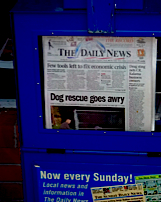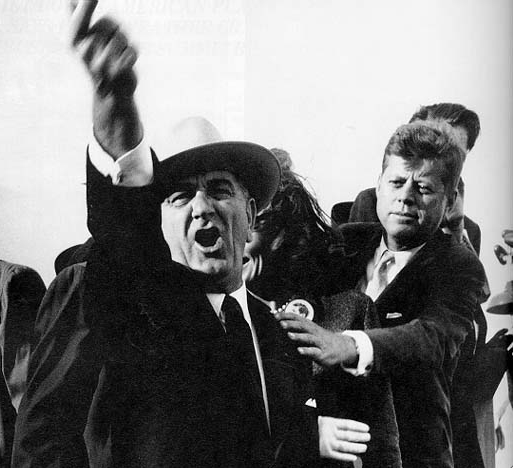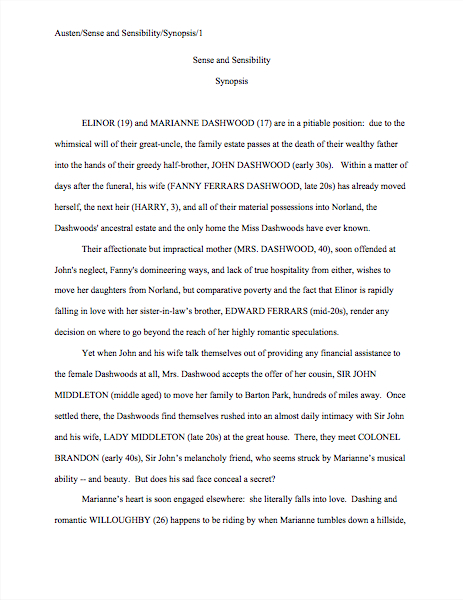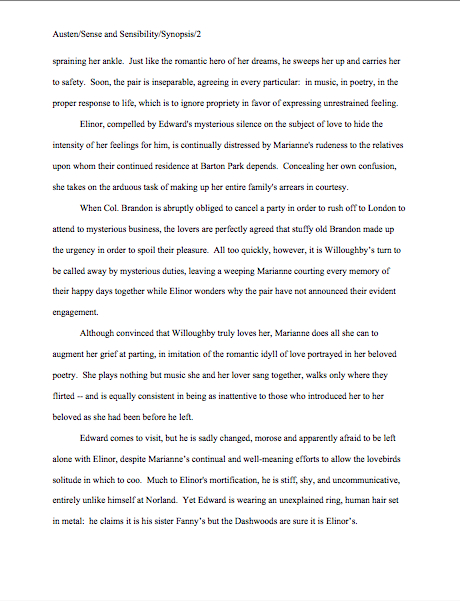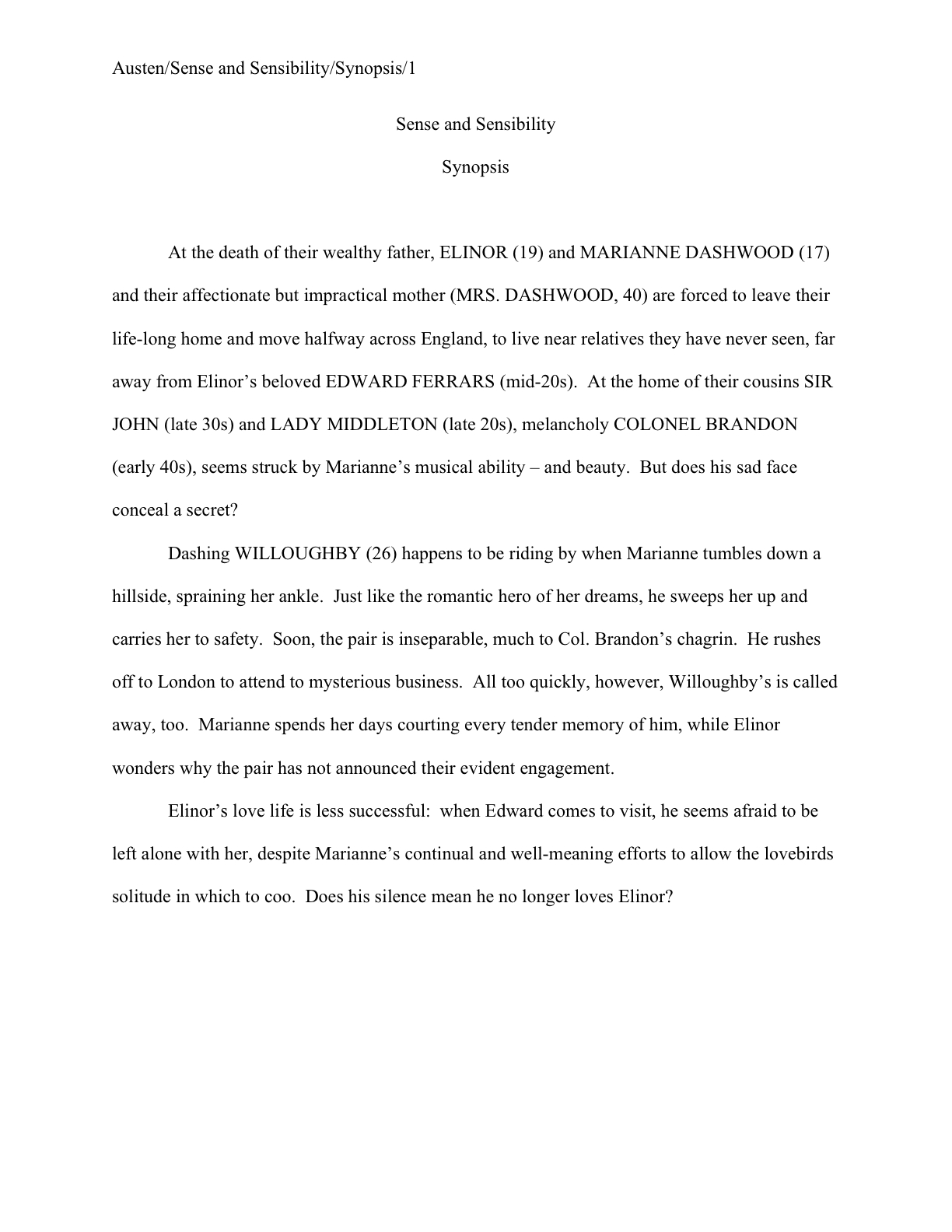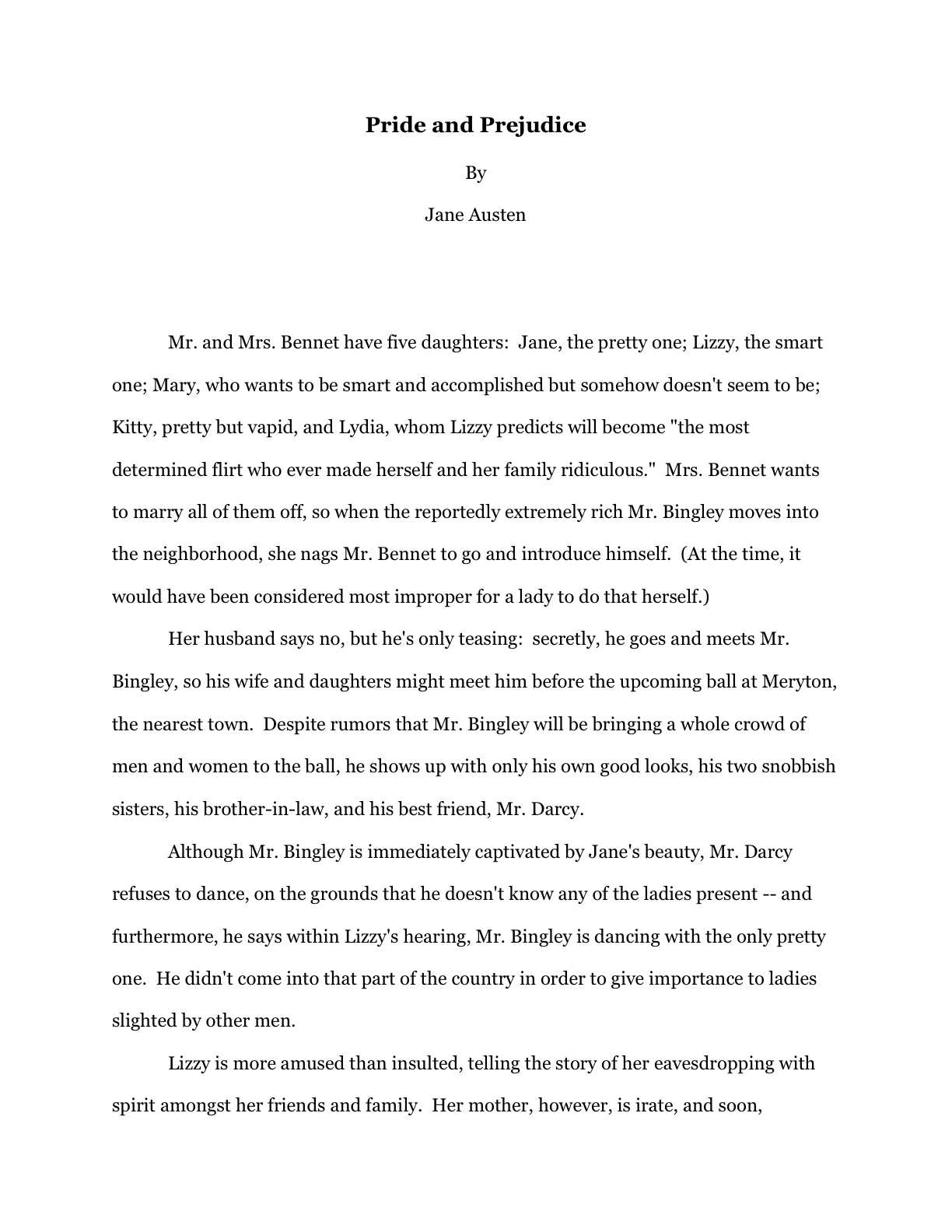This is, in my humble opinion as a novelist, quite possibly the greatest newspaper headline in the history of the printed word; I came across it outside a small-town diner this morning. It’s so delightfully human, isn’t it? The stock market is in distress, the polar icecaps are melting, and a sign in the restaurant window testified to the number of local young people currently serving in active combat (and, tragically, the two who no longer are), yet what concerns the citizens of this hamlet? Budget cut-related turmoil at the dog shelter.
I was charmed.
If that headline appeared in a novel about small-town America, it simply wouldn’t be believable — proving yet again something that I have often maintained on this blog, that reality tends to be a lousy writer. Just because something happens doesn’t necessarily mean that it will seem plausible on the page.
It’s the writer’s job to make it so.
That’s enough free-association for one day, I think. Let’s meander back to our ongoing list of questions designed to ferret out the most pervasive of synopsis problems. To recap:
(1) Does my synopsis present actual scenes from the book in glowing detail, or does it merely summarize the plot?
(2) If the reader had no information about my book other than the synopsis, would the story or argument make sense? Or is more specific information necessary to render the synopsis able to stand alone?
(3) Does the synopsis make the book sound compelling? Does it make me eager to read it?
(4) Does the synopsis tell the plot of the book AS a story, building suspense and then relieving it? Is it clear where the climax is and what is at stake for the protagonist? Or does it merely list all of the events in the book in the order they appear?
(5) Have I mentioned too many characters in the synopsis? Does each that I mention come across as individually memorable?
(6) In a novel synopsis, is it clear who the protagonist is?
(7) Does my protagonist/do my protagonists come across as an interesting, unusual person(s) involved in an interesting, unusual situation?
(8) In a memoir synopsis, is it clear who the protagonist is? Does s/he come across as an interesting, unusual person involved in an interesting, unusual situation?
(9) In either a novel or a memoir synopsis, is it clear what the protagonist wants and what obstacles are standing in the way of her getting it? Is it apparent what is at stake for the protagonist if she attains this goal — and if she doesn’t?
(10) In a NF synopsis that isn’t for a memoir, is it clear what the book is about? Does the subject matter come across as interesting, and does the synopsis convey why this topic might be important enough to the reader to make him/her long to read an entire book about it?
(11) Does my synopsis make the book sound just like other books currently on the market, or does it come across as original?
Everyone clear on those? Superb. Let’s proceed to something fresh — actually, while it’s in the front of my mind, let’s go ahead and address the plausibility issue.
(12) If I’m marketing fiction or memoir, does my synopsis make the story I’m telling seem plausible? If my book is nonfiction, does it come across as both plausible and as though I’m a credible source?
I could sense some of the novelists out there rolling their eyes before I even finished typing #12. “Um, Anne?” a few of you scoffed. “What part of FICTION don’t you understand? By definition, fiction writers make things up.”
Quite true, oh scoffers, but for even the most outrageously fantastic storyline to hang together, it must be plausible — at least in the sense that the characters would actually do and say the things they do and say on the page.
Yes, even in a novel where obeying the law of gravity is merely optional. Otherwise, it’s hard for the reader to remain involved in the story.
Why? Well, when a reader is swept up in a drama (or a comedy, for that matter), she engages in behavior that Aristotle liked to call the willing suspension of disbelief. Basically, she enters into a tacit understanding with the author: the rules that govern the world of the book, no matter how wacky or impractical they may be for the reader’s world, are precisely what the narrative says they are. Most of the time, as long as the narrative abides by them, the reader will be willing to go along for the ride.
Note that as long as clause. If a narrative violates its own rules, the agreement is violated: in thinking, “Wait, that doesn’t make sense,” the reader is knocked out of the story. (Ditto, incidentally, when a first-person or tight third-person narrative suddenly switches, however momentarily, from the protagonist’s perspective to something that the protagonist could not possibly perceive. But perspective-surfing is a subject for another blog post.)
Millicents are notoriously sensitive to being pulled out of a story by a plausibility problem. So are their bosses, the agents who employ them to reject as high a percentage of submissions as possible, and the editors to whom those bosses sell books.
I just felt some of you go pale. “How sensitive?” those of you who have submitted recently enough that you haven’t yet heard back squeak in unison.
Are you sitting down? Got the smelling salts handy? I hate to be the one to break it to you, but in a manuscript, a single instance is often an automatic rejection offense.
Yes, even in a synopsis.
Why? Well, any gaffe that breaks the reader’s suspension of disbelief is, ultimately, a storytelling problem. Thus, Millicent may be excused for thinking as soon as she casts her hyper-critical eye over one, “Oh, this writer isn’t a very consistent storyteller.”
Okay, so this may be an unfairly broad conclusion to draw from a line or two in a synopsis — especially when, as we’ve discussed earlier in this series, many, many talented aspiring writers simply throw together their synopses at the last possible minute prior to sealing the submission or contest entry envelope. But lest we forget, Millicents are in the BUSINESS of making snap judgments; they couldn’t get through the hundreds of queries and submissions they see every week otherwise.
Aren’t you glad you had those smelling salts handy?
If you’re not absolutely certain that your synopsis is internally consistent enough to pass the plausibility test, have someone else (NOT someone who has read the manuscript, ideally) read it and tell the story back to you. Better yet, have someone else read it, tell the story to a third party, and have the third party try to reproduce it for you AND a fourth person.
You may not catch the “Hey, wait a minute!” moments, but chances are that #4, at least, will. Listen carefully to any follow-up questions your experimental victims may have; address them in the synopsis, so that Millicent will not be moved to ask them of the ambient air at the screening stage.
Pay particular attention to any spot in the text the provokes an unexpected giggle. Few narrative gaffes provoke bad laughter — the giggles that spring from readers or audience at a spot where the writer did not intend for them to laugh — as readily as deviations from the internal logic of a story.
This isn’t a bad fix-it strategy for nonfiction, either, especially for memoir. Too often, NF writers in general and memoirists in particular assume that just because they are recounting true events, their narratives will be inherently plausible.
It’s just not true.
Just as a novel’s plausibility depends upon the narrative’s consistently following its story’s internal logic, a NF account or argument needs to hang together, with no missing steps. In a manuscript, plausibility problems tend to arise from incomplete set-ups and telling stories out of chronological order.
(If any of you would like me to elaborate upon these in the weeks to come, I would be delighted; leave a comment below. For today’s purposes, I’m going to move on.)
Where NF synopses usually fall down on the job is by providing insufficient background — prompting questions like, “Why did this happen?” Again, you will be much, much better off if you can solicit such questions from someone other than Millicent, so you may address them before she reads your synopsis.
I really went to town on that last point, didn’t I? I’m going to gloss over the rest of the synopsis questions quickly, so I can polish them off today and send you on your merry way for the weekend.
Don’t worry; the rest are pretty self-explanatory.
(13) Does the first couple of paragraphs of my synopsis Is there an indelible image that the reader can take away?
To put it another way, does the opening of the synopsis contain something both unique and memorable? A vivid sensual image, for instance? A surprising juxtaposition of words? A fresh emotional dilemma?
And so forth. As with a contest entry, screeners tend to pass judgment upon synopses pretty fast — and, in order to approve them for continuing on to the next step of the screening process, often need to be able to describe the book in just a sentence or two. Giving Millicent (or a contest judge) a fantastic detail will make her job easier.
Trust me, you want to make her job easier.
What you DON’T want to do — oh, you may think you do, but it’s not in your best interest — is to make your job as a synopsizer easier by reusing text from the first chapter of the book. Especially, as synopsis-writers for contests so often do, by recycling the opening paragraph of the book.
Which leads me to…
(14) Does the opening of the synopsis read too like the opening of the book?
This may make some of you giggle, but you wouldn’t believe how often the first paragraph or two of manuscript are actually identical to the first paragraph or two of its synopsis. Yes, even in contest entries, where the synopsis and chapter are almost always read within the same sitting.
Millicent and her ilk tend to regard this as a symptom of authorial laziness, but I suspect that there is usually more to it than that: I think that aspiring writers, having slaved to create a memorable opening for their books, often regard those opening paragraphs as some of their best writing. If it really is so, they reason, why not feature it in a document where it’s likely to do them some good?
If you believe nothing else I tell you today, please believe this: it won’t do you any good. People in the publishing industry remember what they’ve read; make sure every sentence you submit within a packet is different.
(15) Is my synopsis in the present tense and the third person, regardless of the tense and voice of the book itself? For a memoir, is it in the first person and past tense?
This is one of those secret-handshake things that render a rookie’s submission so apparently different from an experienced writer’s, from Millicent’s perspective: a professional synopsis is ALWAYS in the present tense and third person, unless the book in question is a memoir.
Yes, even if the book being synopsized is written in the first person. Don’t fight it; it’s just a convention of the trade.
(16) Are its pages numbered?
Even after years of reading synopses intended for submission, I remain perennially shocked at how few of them identify either themselves or the author, due no doubt to a faith in the filing systems of literary agencies that borders on the childlike.
Why do I attribute this to faith? Well, like everything else in a manuscript or book proposal, the synopsis should not be bound in any way; like pretty much everything else on earth, paper responds to gravity.
Translation: things fall; pages get separated, and some luckless soul (generally, the person under Millicent the screener on the agency’s totem pole, if you can picture that) is charged with the task of reordering the tumbled pages.
Place yourself in that unhappy intern’s Doc Martens for a moment: given the choice between laboriously guessing which page follows which by perusing content, and pitching the whole thing (into what we devoutly hope is the recycling bin, but is probably merely the overloaded wastepaper basket) and moving on to the next task, which would YOU choose?
Okay, so maybe you’re ultra-virtuous. Allow me to rephrase: what if you were Millicent, had 20 other submissions to screen before lunch, and had just scalded your tender tongue on a too-hot latte?
Don’t rely upon the kindness of strangers. Especially busy ones who have been trained to believe that unnumbered pages are unprofessional in a submission. Make it easy to put the pages back in the proper order.
(17) Does the first page of the synopsis SAY that it’s a synopsis? Does it also list the title of the book, or does it just begin abruptly? And does every page of the synopsis contain the slug line AUTHOR’S LAST NAME/TITLE/SYNOPSIS/#?
Standard format for a synopsis dictates that the title (either all in caps or bolded) is centered at the top of the first page of the synopsis, with “Synopsis” on the line below it. Then skip one double-spaced line, and begin the text of the synopsis.
And if it seems a bit silly to tell the nice people who asked you to send a synopsis that what they’ve got in their trembling hands is in fact a synopsis, remember that in a largish agency, the person who requests a submission is often not the person who subsequently reads it. Not the first person, anyway.
Even if it were, from the envelope-opener’s perspective, being expected to recall one request for further materials from — how long? Perhaps a month? — before is tantamount to being asked to guess how many fingers the author is holding up.
In Nebraska, when the guesser is standing in midtown Manhattan. Don’t make ‘em guess.
(18) Is the synopsis absolutely free of errors of any kind? Not just what your word processing software tells you is an error, but an actual error?
Naturally, you should both spell-check and read the ENTIRETY of your synopsis IN HARD COPY, ALOUD, before you send it anywhere. Period. No excuses.
95% of writers — and 99.98% of non-writers — fall into the trap of thinking that if a document passes muster with their computers’ spelling and grammar checkers, it must therefore be spelled correctly and grammatically sound. That is, alas, generally not true.
Word processing programs’ dictionaries are NOTORIOUSLY inaccurate — and often surprisingly outdated. I am fascinated by the fact that mine evidently does not contain any words that relate to the Internet or computer operations.
Don’t believe me? Should I really have had to introduce “blogger” into its vocabulary?
And don’t even get a professional editor started on the chronic inadequacies of most word processing programs’ grammar checkers. Mine disapproves of gerunds and semicolons, apparently on general principle, strips necessary accent marks off French words, leaving them obscenely naked, and regularly advises me to use the wrong form of THERE. (If anybody working at Microsoft does not know the ABSOLUTELY IMMUTABLE rules governing when to use THERE, THEIR, AND THEY’RE, I beg you, drop me a comment, and I shall make everything clear.) Once, when I was not looking, it incorrectly changed a word in this very blog from “here” to “hear.”
Editors like to fantasize about the special circle of hell reserved for those amoral souls who teach our children that the differences between these don’t matter. I’ll spare you the details, but they include the constant din of fingernails on chalkboards, a cozy relationship with angry skunks, and the liberal application of boiling oil to tender parts.
Grammar checkers also typically butcher dialogue, especially if it contains necessary slang. Suffice it to say, most standard word processing spelling and grammar checkers would condemn the entirety of Mark Twain’s opus outright.
My point is, like a therapist who doesn’t listen well enough to give good advice, a poor grammar checker cannot be sufficiently disregarded. Even in the unlikely event that your grammar checker was put together by someone remotely familiar with the English language as she is spoke, you should NEVER rely solely upon what it tells you to do.
Read the manuscript for yourself.
And if you’re in doubt on a particular point, look it up. In a well-regarded dictionary, not on the Internet: contrary to popular opinion, most search engines will list both the proper spelling of a word and the most common misspellings. There is no gigantic cosmic English teacher monitoring proper spelling and grammar on the web.
So get up, walk across the room, and pick up a physical dictionary, for heaven’s sake. After so much time spent sitting in front of a monitor, the walk will do you good.
(19) Are all of the proper nouns spelled correctly?
This is a perennial agents’ pet peeve, and with good reason: believe it or not, misplaced cities, states, and even character names are rife in synopses.
Why? Because these are words that are generally omitted from standard spell-checkers — or are entered with a number of possible variations. So unless you have inserted all of the proper nouns in your work into your spell-checker’s memory, it will often overlook the difference between your elegant heroine, Sandy, and that trollop who wandered into your synopsis unbidden, Sandie.
Triple-check all character and place names.
(20) Does the synopsis read as though I am genuinely excited about this book and eager to market it, or does it read as though I am deeply and justifiably angry that I had to write it at all?
Yes, I’ve talked about this one before, and recently, but this is a subtlety, a matter of tone rather than of content, so it bears repeating. It’s often not as visible to the author as it is to a third party.
As I MAY have mentioned earlier in this series, writerly resentment shows up BEAUTIFULLY against the backdrop of a synopsis, even ones that do not breathe an overt word about marketing. The VAST majority of synopses (particularly for novels) simply scream that their authors regarded the writing of them as tiresome busywork instituted by the industry to satisfy some sick, sadistic whim prevalent amongst agents, a hoop through which they enjoy seeing all of the doggies jump.
If you have even the vaguest suspicion that your synopsis — or, indeed, any of your marketing materials — may give off a even a whiff of that attitude, hand it to someone you trust for a second opinion.
Made it through all of the questions above? After you have tinkered with the synopsis until you are happy with all of your answers, set your synopsis aside. Stop fooling with it. Seriously — there is such a thing as too much editing.
Then, just before you send it out, read it again (IN HARD COPY and OUT LOUD, naturally), and ask yourself a final question:
(21) Finally, does my synopsis support the image of the book I want the requesting agent or editor to see? Would it be worth my while to modify it slightly in order to match more closely to what I told this sterling individual my book was about?
”Wait!” I hear some sharp readers out there cry. “Is Anne saying that it’s sometimes a good idea to tailor the synopsis to the particular agent or editor? Catch me — I’m about to faint with surprise!”
Well caught, those of you who thought that. Yes, I am the queen of specialized submission packets. Down with genericism, I say!
It’s just common sense, really. If you heard an agent or editor expresses a strong personal preference for a particular theme or style in her speech at an agents’ and editors’ forum or during a pitch meeting, isn’t it just common sense to tweak your already-existing synopsis so it will appeal to those specific likes? If your dream agent let slip in your meeting that she was really intrigued by a particular aspect of your story, doesn’t it make sense to play that part up a little in the synopsis?
Doesn’t it? Huh?
A word of warning about pursuing this route: do NOT attempt it unless you have already written a general synopsis with which you are pleased AND have saved it as a separate document. Save your modified synopsis as its own document, and think very carefully before you send it out to anyone BUT the agent or editor who expressed the opinions in question.
Why? Well, contrary to popular belief amongst aspiring writers and as I have been pointing out for several years now in this very forum, agents and editors are not a monolithic entity with a single collective opinion on what is good and what is bad writing. They are individuals, with individual tastes that vary wildly, sometimes even moment to moment — and certainly over the course of a career.
Think about it: was your favorite book when you were 13 also your favorite book when you were 30? Neither was any given agent’s.
And isn’t your literary opinion rather different on the day you learned that you were being promoted at work and the day that your cat died? Or even the moment after someone complimented your shirt (it brings out your eyes, you know, and have you lost a little weight?), as opposed to the moment after you spilled half a cup of scalding coffee on it?
Again, what’s true for you is true for any given agent, editor, or screener: a LOT of factors can play into whether they like the pages sitting in front of them — or the pitch they are hearing — right now. As the old international relations truism goes, where you stand depends upon where you sit.
Bear this in mind when you are incorporating feedback into your synopsis — or, indeed, any of your work. Just because one agent (or an editor, or a contest feedback form, or every last member of your writers’ group, or the Wizard of Oz) has advised you to tweak your story this way or that, it doesn’t necessarily mean everyone in the industry will greet that tweak rapturously.
Use your judgment: it’s your book, after all. But by all means, if you can modify your synopsis for the SPECIFIC eyes of the individual who expressed the particular opinion in question, do it with my blessings.
Whew, that was a long one, wasn’t it! Make those synopses shine, everybody, and keep up the good work!
